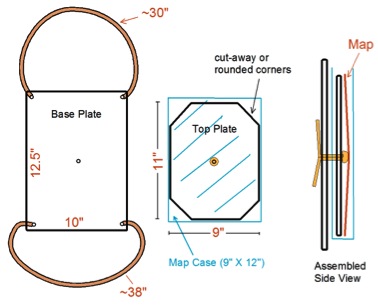ski orienteering map holder
One of the biggest issues faced by a ski-orienteer is "How Do I Hold My Map????". There have been many schemes attempted - here are four of them, from cheap and pretty useless, to pricey and great.
Stuff it in your pocket / hold it in your hand with your ski pole
The ultimate "I didn't think ahead at all" solution. It'll do in a pinch (since you won't have any other option).
Pros: No preparation required. No cost.
Cons: Common problems include: the map falls out and you lose it, the map gets
torn and shredded and you can't read it, it takes a long time to get the map out
and figure out where you are, it slows you down a lot when trying to read it.
Dirt bag map holder - the "Antoine" model
With a little preparation you can take a step up using the following common items:
- a normal sheet protector that has three holes for putting into a three-ring binder
- a bit of tape
- a lanyard (like you get at conferences). Ideally with a metal clip that rotates. And for safety, with a "breakable" latch
Assembly instructions:
- attach the lanyard's ring onto the middle hole of the sheet protector
- put the map into the sheet protector
- tape closed the open end (otherwise the map will fly out while you are skiing).
This is how Antoine Arcand, Sports School Lead Instructor, did it for the schools program at Whistler Olympic Park in 2013, and it works just great. Thanks for the tip Antoine.
Pros: Hands-free while skiing. Map is protected from getting wet / ripping.
Quick access to the map, while stopped and while moving.
Cons: Map flaps about while skiing. Need to orient the map when you grab it.
Tough to follow as you ski.


A Rudimentary Map Holder - the "Anderson" model
Once you've completed a few ski orienteering courses you will find that trying to follow your ski-O course on a hand-held map in a slippery map case is really awkward with ski-gloves and poles in your hands! The basic solution is to pin the top of the plastic map case to your jacket so you can flip up the map from the bottom to read it. But that method means you cannot turn the map to the direction you want to travel!
For a dirt-bag solution on the other hand you can make, for about $3, a simple map holder with pivoting top plate. The base plate and top plate can be foam board or similar material. The neck and waist elastic should be stretchy enough to pivot the board easily towards you from the bottom. The plates are firmly held together with a large brass split pin. A standard map case that has been pulled over the top plate before attaching it to the base plate holds the map. The head of the split pin should also be inside the map case so the map slips easily into the case. Duct tape the split ends of the pin securely against the base plate to avoid snags.


OK, so it does not look very snazzy - but it works. Bring a strip of tape with
you to seal map case closed after you insert the map at the Start Line.
The only operational problem is that after you have turned the top plate and
studied the next leg of your course, it will probably not stay in the same
position as you ski along the trails. You can use clothes pegs, large fold-back
clips, etc. to hold it firmly (in it's new position) against the base. A more
elegant solution would be a plate-to-plate fastener that you could easily loosen
or tighten with gloves on! I leave that up to you to invent.
Thanks to Bill A (Ottawa Orienteering Club)
Pros: Pretty effective - map rotates, map is protected, map is handy when you
want it.
Cons: Map not always visible.
What the Pros use - the "Nordenmark" or "Miry" holders
For a high-end product you can buy ($100 + shipping) a fancy body-harness map holder with pivoting top plate like the "pros" use. Check out the O-Store.ca who carry the NordenMark ($110) and Miry ($90) holders. These are really good and what top level competitors will always be using.
Pros: map is always visible while you ski, rotating plate so you can keep the
map oriented, inserting map is fast (good for map exchanges too)
Cons: still no way to track your current location while you ski
